
Firs are evergreen coniferous trees belonging to the genus Abies in the family Pinaceae. There are approximately 48–65 extant species, found on mountains throughout much of North and Central America, Europe, Asia, and North Africa. The genus is most closely related to Cedrus (cedar). The genus name is derived from the Latin "to rise" in reference to the height of its species. The common English name originates with the Old Norse, fyri, or the Old Danish, fyr.

Picea abies, the Norway spruce or European spruce, is a species of spruce native to Northern, Central and Eastern Europe.

Abies nordmanniana, the Nordmann fir or Caucasian fir, is a fir indigenous to the mountains south and east of the Black Sea, in Turkey, Georgia and the Russian Caucasus. It occurs at altitudes of 900–2,200 m on mountains with precipitation of over 1,000 mm.
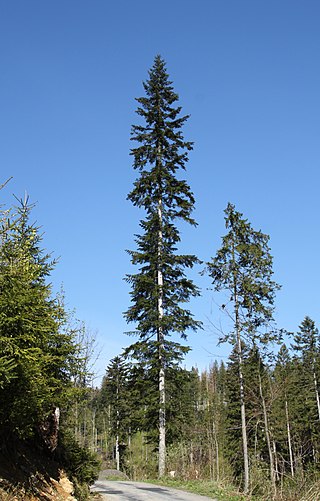
Abies alba, the European silver fir or silver fir, is a fir native to the mountains of Europe, from the Pyrenees north to Normandy, east to the Alps and the Carpathians, Slovakia, Slovenia, Croatia, Bosnia and Herzegovina, Montenegro, Serbia, and south to Italy, Bulgaria, Kosovo, Albania and northern Greece.

Abies grandis is a fir native to northwestern North America, occurring at altitudes of sea level to 1,700 metres (5,600 ft). It is a major constituent of the Grand Fir/Douglas Fir Ecoregion of the Cascade Range.

Abies concolor, the white fir, concolor fir, or Colorado fir, is a coniferous tree in the pine family Pinaceae. This tree is native to the mountains of western North America, including the Sierra Nevada and southern Rocky Mountains, and into the isolated mountain ranges of southern Arizona, New Mexico, and Northern Mexico. It naturally occurs at elevations between 900 and 3,400 metres.
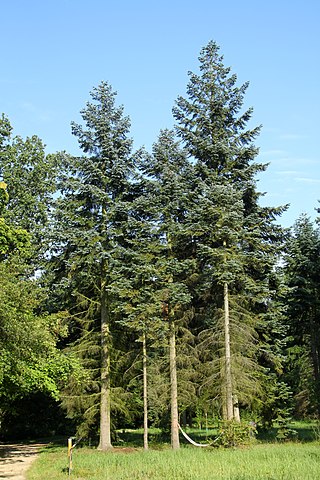
Abies procera, the noble fir, also called red fir and Christmas tree, is a species of fir native to the Cascade Range and Pacific Coast Ranges of the northwestern Pacific Coast of the United States. It occurs at altitudes of 300–1,500 meters (980–4,920 ft).

Abies lasiocarpa, the subalpine fir or Rocky Mountain fir, is a western North American fir tree.
The Botanical and Zoological Codes of nomenclature treat the concept of synonymy differently.

Zeiraphera ratzeburgiana, the spruce bud moth or Ratzeburg tortricid, is a moth of the family Tortricidae. It is found from northern and central Europe to eastern Russia and China. Zeiraphera ratzeburgiana is a taxonomically similar species to Zeiraphera canadensis and can only be distinguished by an anal comb found in Z. canadensis.

The Western Himalayan subalpine conifer forests is a temperate coniferous forests ecoregion of the middle and upper elevations of the western Middle Himalayas of Nepal, India, and Pakistan.

Dichelia histrionana is a species of moth of the family Tortricidae. It is found from Fennoscandia to Belgium, Italy and Greece and from the Netherlands to Poland and Romania.
Pseudohermenias ajanensis is a species of moth of the family Tortricidae. It is found in the Russian Far East, China and Japan.
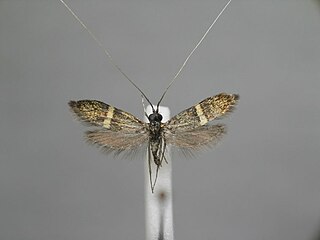
Nemophora associatella is a moth of the Adelidae family. It is found from Germany and Poland to the Pyrenees, Italy and the Balkan Peninsula. It is also present in Russia.

Argyresthia fundella is a moth of the family Yponomeutidae. It is found in most of Europe, except Ireland, Great Britain, the Iberian Peninsula, Finland, the Baltic region, Slovenia, Hungary and Greece.
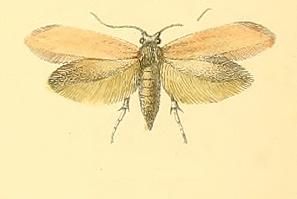
Argyresthia bergiella is a moth of the family Yponomeutidae. It is found in most of Europe, except Ireland, Great Britain, Belgium, the Iberian Peninsula and most of the Balkan Peninsula.

Denisia stipella is a moth of the family Oecophoridae. It is found in almost all of continental Europe, except the Iberian Peninsula and the southern part of the Balkan Peninsula.
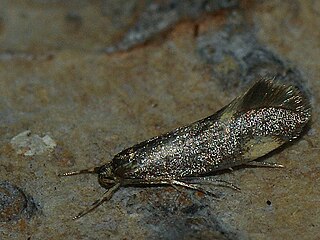
Metalampra cinnamomea is a moth of the family Oecophoridae. It was described by Philipp Christoph Zeller in 1839. It is found in most of Europe, except the Iberian Peninsula, most of the Balkan Peninsula, Ireland and Great Britain.
Acleris nigrilineana is a species of moth of the family Tortricidae. It is found in Korea, Japan, the Russian Far East and Denmark, Norway, Sweden, Finland, Poland, European Russia, Estonia and Latvia.

Acleris abietana, the Perth button, is a species of moth of the family Tortricidae. It is found in Europe, where it has been recorded from Great Britain, Ireland, France, Belgium, the Netherlands, Germany, Denmark, Austria, Switzerland, Italy, the Czech Republic, Slovakia, Slovenia, Poland, Hungary and Russia. The habitat consists of coniferous woodlands.

















